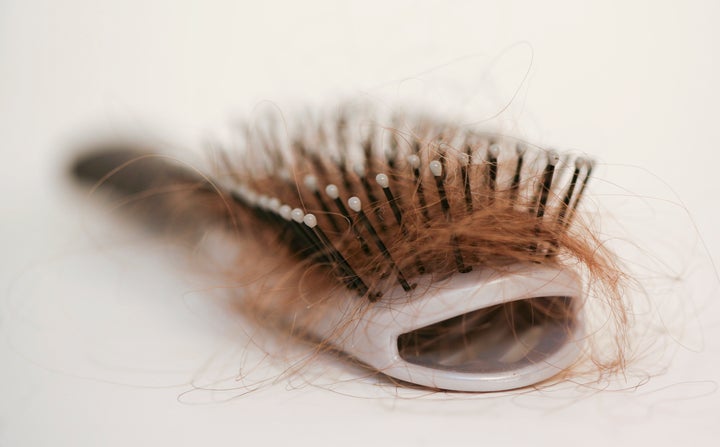
Maybe you’re noticing more hairs in your brush or more strands shedding while you shower. Clogged drains aside, this can be cause for concern for many. Hair shedding — losing roughly 100 strands a day — is completely normal and occurs as part of the natural hair growth cycle, according to Dominic Burg, a hair and scalp specialist called a trichologist who’s the chief scientist at Evolis Professional.
If you’re having trouble deciding what’s “normal” and what may be a concern, keep reading.
Normal hair shedding vs. serious hair loss
Hair loss can be panic-inducing, but it’s different from hair shedding.
“Hair loss is generally characterized by a significant change, disruption or dysfunction in the hair growth cycle,” explained Burg, whose company sells hair-care products. “This can happen for a variety of reasons, including genetics, age, diet, hormonal changes, lifestyle and life events, as well as inflammatory pathologies.”
Hair shedding, on the other hand, is based on the fact that each hair follicle follows its own hair cycle. Because they aren’t synchronized with each other, you won’t shed them all at once, but rather, at a rate of about 80 hairs to 120 hairs a day, Burg explained.
If you tend to wait a few days between hair washes, you may notice what may appear to be excess hair shedding, but that’s actually not a sign you’re losing hair.
“If you haven’t washed your hair for a few days you’ll have some hairs that have been released from the follicle pore or shed from the scalp, but are still present on the head — either tangled up with other hairs or just very loosely connected to the scalp,” Burg said. “The longer you wait between washes, the more hair will build up like this, so that when you do finally wash, it may look like you’re shedding a lot at once. But you’re actually just releasing a proportion of a few days’ worth of shedding.”
Where things get worrisome, however, is if you’re noticing that you’re losing more than the normal amount of daily hair shed. Thankfully, you don’t have to individually count the hairs to figure this out.
Serious hair loss can take many forms, depending on the reasons behind it. Alopecia areata, an inflammatory and autoimmune form of hair loss, is a serious condition that occurs when there’s a loss of large numbers of hairs at once, presenting itself as round bald patches on the head, Burg said. If you notice that you’re losing hair on other areas, such as your eyelashes or eyebrows, this could be a sign of alopecia universalis.

Some other forms of hair loss may not be as serious, but can still warrant a visit to your doctor. For example, hormonal hair loss, which trichologist Gretchen Friese said usually shows up on the temples, on the crown of the head, or on the top front of the head, is usually a temporary form of hair loss.
Another form is diffuse hair loss, which is when the scalp starts to show through the hair all over the head, said Friese, who’s certified by BosleyMD, which sells hair regrowth products.
This can be stress-induced, isn’t usually associated with itching or burning, and the shed is usually self-limiting (meaning, it only lasts a month or two), Burg explained.
Stress-induced hair loss and COVID-19
Stress-induced hair loss spiked in 2020 amid the COVID-19 pandemic. While studies have shown that the COVID infection itself caused hair loss in about 20% of people who have contracted the virus (likely due to the trauma on the body caused by high fevers and prolonged illness, Friese said), the generalized stress of the pandemic is also causing people to lose their hair.
“Staying home, financial issues, home schooling, being away from loved ones, fear of becoming ill, and social restrictions are some of the reasons that people are feeling more stress right now — and stress can be a huge reason for hair loss,” Friese said.
Still, there are ways to cope with the anxiety that a pandemic can bring. For Sharleen St. Surin-Lord, a board-certified dermatologist who specializes in hair, it’s important to incorporate mind, body, lifestyle and gut health into the management of skin and hair conditions.
“I advise my patients in high-pressure positions or situations — and those who suffer from anxiety — to meditate one to two times daily, listen to ocean waves, and practice deep breathing techniques,” St. Surin-Lord said. “I also recommend going for walks for fresh air, and when necessary, send a referral to a psychiatrist.”
Seasonal hair loss
No, you’re not imagining it. The hair shedding that you’re noticing at the onset of fall and winter could actually be related to the season. According to Friese, some studies have shown that we have the highest number of hairs in the telogen phase, or resting phase, in July.
“Hairs in the telogen phase will generally fall out about 100 days after entering that stage, which means that people may see more shedding toward the end of summer and into the fall,” Friese said.
“The idea behind ‘seasonal hair loss’ is that during the summer months, we hang on to more hair to provide increased protection from the sun. We then shed those hairs to make room for thicker hairs to grow in winter,” Friese explained.
Burg also made this point, adding that during the winter, our bodies may be getting ready to produce new hairs close to the scalp to help with insulation, which can result in hair shedding as the body pushes out the older hairs to get us ready for a cold winter.
When to visit your doctor
Essentially, any time there is loss of large quantities of hair that’s unexplainable (for example, you’re not postpartum or undergoing chemotherapy), you should pay a visit to your doctor.
Red bumps or pus bumps on the scalp, tenderness, soreness or intense itching also require an immediate visit to the dermatologist, St. Surin-Lord said. These are signs of inflammatory hair loss and can lead to scarring, which can result in permanent hair loss.
“Early intervention is essential to saving one’s hair in these situations,” she said.
Regardless of the type of hair loss, there are treatment options available, Berg noted. They range from cosmetic products to volumize and mask any temporary hair loss to medications that help with inflammatory hair loss as well as treatments to boost hair growth.
